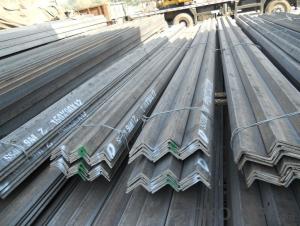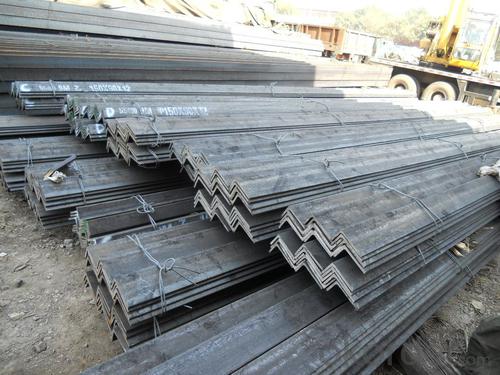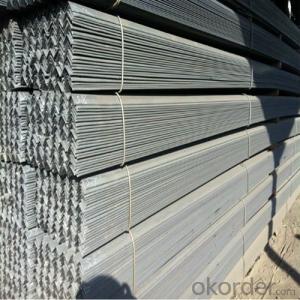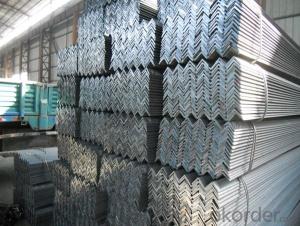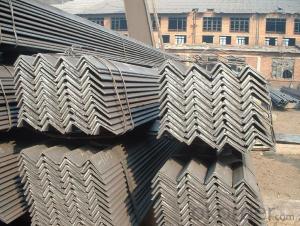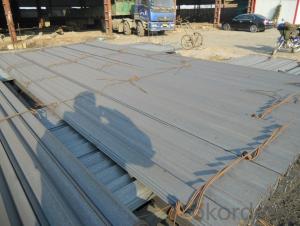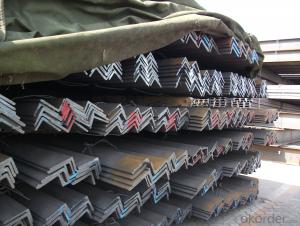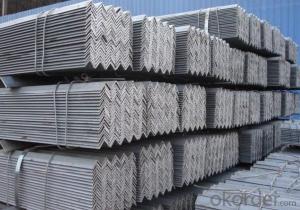High Quality Unequal Steel Angle
OKorder Service Pledge
OKorder Financial Service
You Might Also Like
Specifications of Unequal Steel Angle:
1.Standards: GB
2.Length: 6m,9m,12m
3.Material: Q235, Q345 or Equivalent
4. Size:
Size (mm) | Mass (mm) | Size (mm) | Mass (mm) |
| 150*75*9 | 15.4 | 150*90*9 | 16.5 |
| 150*75*10 | 17.0 | 150*90*10 | 18.2 |
| 150*75*12 | 20.2 |
Packaging & Delivery of Unequal Steel Angle:
1. Transportation: the goods are delivered by truck from mill to loading port, the maximum quantity can be loaded is around 40MTs by each truck. If the order quantity cannot reach the full truck loaded, the transportation cost per ton will be little higher than full load.
2. With bundles and load in 20 feet/40 feet container, or by bulk cargo, also we could do as customer's request.
3. Marks:
Color mark: There will be color marking on both end of the bundle for the cargo delivered by bulk vessel. That makes it easily to distinguish at the destination port.
Tag mark: There will be tag mark tied up on the bundles. The information usually including supplier logo and name, product name, made in China, shipping marks and other information request by the customer.
If loading by container the marking is not needed, but we will prepare it as customer request.
*If you would like to get our price, please inform us the size, standard/material and quantity. Thank you very much for your attention.
- Q: What are the standard sizes of steel angles?
- The region and industry dictate the standard sizes of steel angles, although there are widely utilized common sizes. Steel angles generally come in equal leg and unequal leg sizes. Equal leg angles have standard sizes ranging from 20x20mm to 200x200mm, with thicknesses ranging from 3mm to 26mm. Unequal leg angles have one leg longer than the other, and their standard sizes range from 25x16mm to 200x150mm, with thicknesses ranging from 3mm to 15mm. These standard sizes find widespread use in construction, engineering, and manufacturing industries for various purposes, including structural supports, framing, and bracing. It is worth noting that these sizes may differ based on project-specific requirements or industry-regulated standards.
- Q: Are steel angles suitable for earthquake-resistant construction?
- Steel angles can indeed be suitable for earthquake-resistant construction. Steel is a material known for its high strength and ductility, making it ideal for withstanding seismic forces. Steel angles, in particular, are commonly used in seismic design and construction due to their ability to provide structural stability. Steel angles are often used as bracing elements in buildings to resist lateral forces caused by earthquakes. They can be installed diagonally between structural members to create a rigid frame that can effectively absorb and dissipate seismic energy. These angles help distribute the forces generated during an earthquake and prevent the collapse of the structure. Furthermore, steel angles can be designed and fabricated to meet specific seismic design criteria. The design can take into account factors such as the building's location, expected seismic activity, and the desired level of earthquake resistance. By using advanced computer-aided design and analysis tools, engineers can optimize the placement and size of steel angles to enhance the overall seismic performance of the structure. In addition to their strength and ductility, steel angles offer other advantages for earthquake-resistant construction. They are lightweight, which reduces the overall weight of the structure and allows for more efficient seismic design. Steel is also a recyclable material, making it a sustainable choice for construction projects. However, it is important to note that the suitability of steel angles for earthquake-resistant construction depends on several factors, including the specific design, construction techniques, and adherence to building codes and regulations. Professional engineering expertise and thorough analysis are necessary to ensure the appropriate use of steel angles in seismic design. In summary, steel angles are suitable for earthquake-resistant construction due to their strength, ductility, and ability to provide structural stability. When properly designed and installed, they can effectively resist seismic forces and contribute to the overall safety and resilience of the structure.
- Q: Can steel angles be fire-resistant?
- Indeed, steel angles possess fire-resistant qualities. Being a material, steel inherently possesses fire resistance due to its high melting point and low thermal conductivity. When faced with elevated temperatures, steel angles can retain their structural integrity and withstand deformation for a significant duration. Furthermore, fire resistance in steel angles can be augmented through diverse approaches, such as the utilization of fire-resistant coatings or the integration of fire-resistant materials in their design. These measures serve to heighten the fire resistance capacity of steel angles, rendering them appropriate for scenarios where fire protection is imperative, such as the establishment of fire-resistant walls, ceilings, and structural systems in construction projects.
- Q: What are the different types of steel angles used in fencing and gates?
- There are several different types of steel angles that are commonly used in fencing and gates. One of the most common types is the equal angle, also known as L-shaped angle. This type of angle has equal length sides and is commonly used for vertical and horizontal bracing in fencing and gates. Another type is the unequal angle, which has one longer side and one shorter side. This type of angle is often used for diagonal bracing in fencing and gates, as it provides additional strength and stability. There is also the rounded edge angle, which has rounded edges instead of sharp corners. This type of angle is often used in fencing and gates to reduce the risk of injury, as the rounded edges are less likely to cause cuts or other accidents. Additionally, there are slotted angles, which have pre-drilled holes along the length of the angle. These holes allow for easy attachment of fencing and gate components, such as panels or hinges. Finally, there are galvanized angles, which have been coated with a layer of zinc to protect against rust and corrosion. This type of angle is ideal for outdoor fencing and gates, as it provides long-lasting durability and resistance to the elements. Overall, the different types of steel angles used in fencing and gates offer various benefits in terms of strength, stability, safety, ease of installation, and resistance to rust and corrosion. The specific type of angle used will depend on the specific requirements and preferences of the fencing or gate project.
- Q: What are the common applications of steel angles in the automotive industry?
- The automotive industry frequently relies on steel angles for a variety of purposes due to their versatility and strength. One specific use in this industry involves the construction of vehicle frames and chassis, where steel angles are commonly employed to ensure structural support and rigidity. This, in turn, guarantees the overall strength and stability of the vehicle. Another common application for steel angles is in the production of brackets and mounting components. These angles are utilized to securely attach various parts - such as engine mounts, suspension components, and exhaust systems - to the chassis of the vehicle. By doing so, steel angles contribute to the proper functioning and longevity of these components. Steel angles are also heavily involved in the creation of safety features within automobiles. For example, they are crucial in the construction of roll cages, which safeguard occupants in the event of a rollover or collision. Due to their exceptional strength and ability to absorb and distribute impact forces, steel angles are preferred for roll cages, ultimately enhancing the safety of the vehicle. Furthermore, steel angles have a wide range of applications in the design and production of various automotive accessories and components. They are commonly utilized as reinforcement in door panels, fenders, and bumpers, elevating the overall structural integrity of these parts. Additionally, steel angles are employed in the fabrication of trailer hitches, tow bars, and roof racks, providing robust and secure attachment points for towing and carrying heavy loads. To summarize, steel angles play a critical role in the automotive industry by offering structural support, facilitating secure connections, enhancing safety, and improving the overall performance and durability of vehicles and their components.
- Q: How do you prevent galvanic corrosion between steel angles and aluminum components?
- To avoid galvanic corrosion between steel angles and aluminum components, there are multiple actions you can take: 1. Implement a barrier: Employ a non-conductive coating or a layer of paint to create a physical barrier between the steel and aluminum surfaces. This will obstruct direct contact between the two metals, decreasing the chances of galvanic corrosion. 2. Use insulating tape or gaskets: Position insulating tape or gaskets made of non-conductive materials, like rubber or plastic, between the steel angles and aluminum components. This will act as a buffer, preventing direct contact and reducing the risk of galvanic corrosion. 3. Select compatible metals: Opt for metals that are more compatible with each other when designing or selecting components. For example, consider using stainless steel or galvanized steel instead of regular steel when paired with aluminum, as this can decrease the risk of galvanic corrosion. 4. Utilize isolation techniques: Isolate the steel angles and aluminum components using techniques like plastic or rubber spacers. These spacers separate the metals, preventing direct contact and minimizing the potential for galvanic corrosion. 5. Apply corrosion inhibitors: Apply special coatings or compounds to the steel and aluminum surfaces that act as corrosion inhibitors. These inhibitors create a protective layer, helping to prevent galvanic corrosion. 6. Control the environment: Galvanic corrosion is accelerated in the presence of moisture, saltwater, or acidic environments. Decrease the exposure of steel angles and aluminum components to these corrosive elements by ensuring proper ventilation, drainage, and maintaining suitable protective coatings. When selecting the most appropriate method or combination of methods to prevent galvanic corrosion between steel angles and aluminum components, it is crucial to carefully consider the specific requirements and conditions of your application. Seeking advice from corrosion experts or engineers can provide valuable insights and tailored guidance for your particular situation.
- Q: How are steel angles protected against atmospheric corrosion?
- Steel angles are protected against atmospheric corrosion through a variety of methods. One common method is by applying a protective coating, such as paint, to the surface of the steel angles. This coating acts as a barrier between the steel and the surrounding atmosphere, preventing the steel from coming into direct contact with moisture or oxygen, which are the main contributors to corrosion. Another method of protection is through galvanization. Galvanization involves coating the steel angles with a layer of zinc, either through hot-dip galvanization or electroplating. The zinc acts as a sacrificial layer, corroding in place of the steel. This sacrificial corrosion process helps to protect the steel angles from atmospheric corrosion. In addition to coatings, steel angles can also be protected through the use of inhibitors. Inhibitors are substances that are added to the surrounding environment or applied directly to the steel surface to slow down or prevent corrosion. These inhibitors work by either forming a protective film on the steel surface or by altering the chemical environment to make it less corrosive. Regular maintenance and inspection are also essential in protecting steel angles against atmospheric corrosion. This includes cleaning the surface of the steel angles to remove any dirt or debris that may trap moisture and accelerate corrosion. It is also important to promptly repair any damaged or deteriorated coatings to ensure continued protection against corrosion. Overall, a combination of protective coatings, galvanization, inhibitors, and regular maintenance is necessary to effectively protect steel angles against atmospheric corrosion and extend their lifespan.
- Q: What are the common methods of joining steel angles together?
- There exist various methods for connecting steel angles together. 1. Welding is a well-liked technique employed to join steel angles. This involves the melting of the angle edges, followed by cooling and solidification to establish a robust bond. Welding can be executed using diverse approaches like arc welding, MIG welding, or TIG welding. 2. Bolting is yet another frequent method used for joining steel angles. It entails using bolts, nuts, and washers to secure the angles in place. This technique permits easy dismantling and reassembly, if necessary. Bolts are typically utilized in combination with gusset plates or brackets to provide added strength and stability. 3. Riveting is a conventional method of connecting steel angles. It necessitates the usage of a rivet, a cylindrical metal pin, to hold the angles firmly. The rivet is inserted into pre-drilled holes in the angles and then deformed on one end to create a head, thereby securing the angles together. 4. Adhesive bonding is a technique that utilizes a specialized adhesive to connect steel angles. The adhesive is applied between the angles, and pressure is exerted to ensure a sturdy bond. Adhesive bonding is often employed in situations where a clean and visually appealing joint is desired. 5. Mechanical fasteners, such as screws, nails, or self-tapping screws, can also be employed to join steel angles. These fasteners are inserted into pre-drilled holes to establish a secure connection. However, they may not possess the same level of strength as other methods like welding or bolting. When selecting the appropriate method for joining steel angles, it is crucial to consider the specific requirements of the application, including load-bearing capacity, aesthetics, and ease of disassembly.
- Q: What are the safety considerations when working with steel angles?
- When working with steel angles, it is crucial to prioritize safety. Some key safety considerations include wearing appropriate personal protective equipment (PPE) such as gloves, safety glasses, and steel-toed boots to protect against potential injuries. Additionally, it is important to handle steel angles with care and use proper lifting techniques to avoid strain or muscle injuries. Adequate training and knowledge of the equipment being used, such as angle grinders or welding tools, is essential to prevent accidents. Finally, maintaining a clean and organized work area can help minimize tripping hazards and ensure a safer working environment.
- Q: Can steel angles be used in construction?
- Yes, steel angles can be used in construction. Steel angles are commonly used as structural elements in construction projects due to their strength, durability, and versatility. They are commonly used to support and reinforce various structures such as buildings, bridges, and industrial frameworks. Steel angles provide stability and structural integrity, making them a suitable choice for construction purposes.
Send your message to us
High Quality Unequal Steel Angle
OKorder Service Pledge
OKorder Financial Service
Similar products
Hot products
Hot Searches
Related keywords

